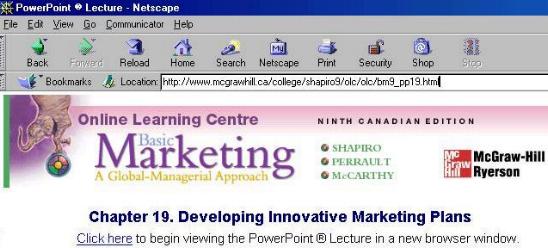 |
|
|
|
|||||
|
Chpt 19

Developing Innovative Marketing Plans |
 |
| . | SWOT - Strength Weaknesses Opportunities
Threats
- this is a concept which students should know from "intro to business" and "intro to marketing" courses. Basically, in simple terms, SWOT Analysis is done to show what you are good at and where you suck, what do you have a chance at doing, and who is out to make your life miserable ! Many of the business and marketing concepts we refer to in marketing and business, such as the 4Ps, the 5 environments, GOPST, SWOT etc, are all fundamentally important - what is required in the online age is to put them into a context that allows for the cyber dynamic. WTGR |
 |
clcik on the screen capture
to see the unit on SWOT
SWOT Analysis
|
Chpt 19
 |
Forecasting
Target Market Potential and Sales
Three Levels of forecast
|
Chpt 19


p. 549-550 9th edition p. 605 10th edition |
.
Sales Analysis depending on various influencing circumstances
|
Chpt 19

Developing Innovative Marketing Plans |
.
Product Life Cycle guide Planning page 515 in text 
 |
| Planning
for Involvement in International Marketing Planning
Planning
Planning
|
|
 |
Online Quiz
questions you can try for Chpt 20
- they are multiple choice http://highered.mcgraw-hill.com/sites/0070887292/student_view0/chapter20/quiz_questions.html |
| Chpt 20
Benchmarking p. 636 10th Edition  |
This is an image of a work
bench
"Bench marking" is an old
term that comes from the time when people would take a competitors product,
put it up on their work bench, look at, see how it works and maybe take
it apart - all for the purpose of comparing that product to their own product.
The term also can be applied
to, literally, marking the bench to see how you measure distance, size,
etc.
"There are numerous definitions of benchmarking, but essentially it involves learning, sharing information and adopting best practices to bring about step changes in performance. So, at its simplest, benchmarking means:" "Improving ourselves by learning from others". |
o regularly
comparing aspects of performance (functions or processes) with best practitioners;
o identifying
gaps in performance;
o seeking
fresh approaches to bring about improvements in performance;
o following
through with implementing improvements; and
o following
up by monitoring progress and reviewing the benefits.
Chpt 20
 |
.
Marketing Managers are responsible for PDOC - or, "stuff bosses do to run things"
p. 548 |
| Chpt 20
Sales Analysis p. 637 10th Edition  |
Controlling
Control method # 1: Sales Analysis A "sales analysis" is a detailed breakdown of a company’s sales records Step 1: Specify the Data to be Captured Step 2: Identify the Analyses to be done
"sales analysis" is a procedure involving the gathering, classifying, comparing, and studying of company sales data. It may simply involve the comparison of total company sales in two different time periods. Or it may entail subjecting thousands of component sales (or sales-related) figures to a variety of comparisons among themselves, with external data, and with like figures for earlier periods of time. |
| Chpt 20
Performance Analysis p. 639 10th Edition  |
Controlling
Control method # 2: Performance Analysis A "performance analysis" is a detailed breakdown of a company’s sales records Performance Indexes
|
.
.
Chpt 20

Iceberg Principle |
Iceberg Principle
p. 555 9th edition
much good information is
hide in summary data
|
| .
.................... |
Virtual companies as
a business model
|
 . . |
Virtual companies as
a business model
. Virtual companies are not just contained to the IT business world but exist in many types of formats in business throughout the globe. One example of the diversity in applying virtual companies as a concept is the famous rap group Wu-Tang Clan.
As TIME magazine noted, (Dec 11th issue, 2000) "The Wu-Tang "brand" blossomed in 1993. Each member of the group periodically goes off and does some solo project from which they develop additional capability and experience, at the same time keeping public their alliance and affiliation with Wu-Tang. The "brand", in the form of the bands members, continue to also put out products under the bands name as well in order to maintain the value of the "base" of their individual reps. The
strength of the company, as explained in TIME, is "... maintaining
just a small core and outsourcing everything else."
|
 . . |
Virtual companies as
a business model
The
band members have so many sites devoted to their activities that Yahoo
has devoted an entire Yahoo category to them
"Everything
else" is their forays into video games, clothing, comics, movies and many
other constantly new and evolving merchandise crossing over and back into
music, video, movies and the internet.
|
|
|
CONTACT IMAIN PAGE I NEWS GALLERY I E-BIZ SHORTCUTS I INT'L BIZ SHORTCUTS I MKTG&BUSINESS SHORTCUTS I TEACHING SCHEDULE |
| . | |
| MISTAKES ITEXTS USED I IMAGES I RANK I FORMER STUDENTS I | |
| . |